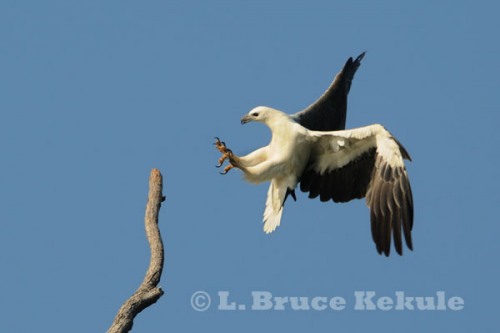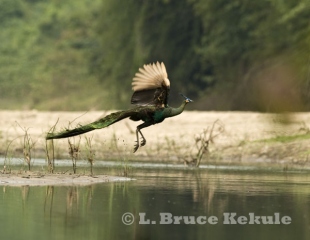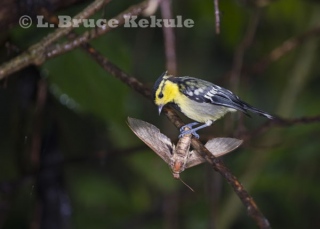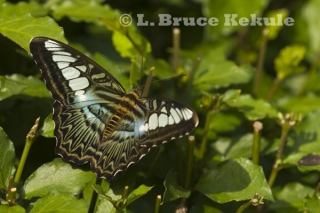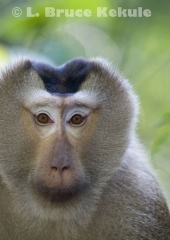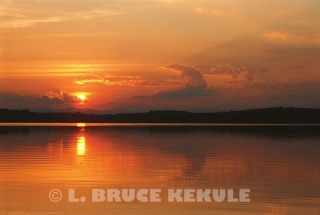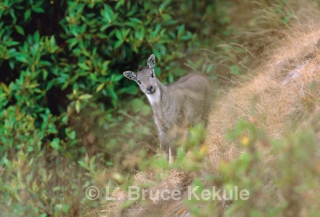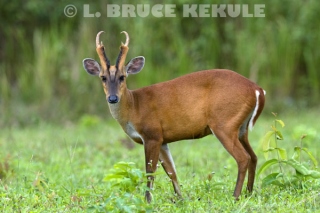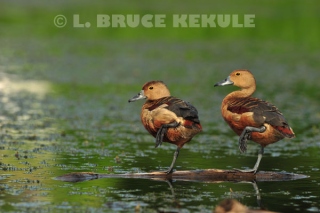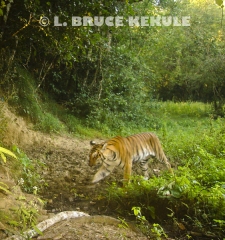Posts Tagged ‘Nature Photography’
Nature Photography
Capturing Thailand’s magnificent wildlife on camera
White-bellied sea eagle in Lam Son National Park
Thailand’s breathtaking wildlife and forests has evolved over millions of years into some of the most beautiful and interesting in the world. Photographing these ecosystems and rare animals such as the tiger, leopard, gaur, banteng, wild water buffalo, elephant, Siamese crocodile and tapir, plus a multitude of other mammals, birds, reptiles, amphibians and insects in their natural habitats is a daunting task to say the least. A multitude of different aspects contribute to the difficult and sometimes dangerous pastime of wildlife photography.
Male green peafowl in Huai Kha Khaeng Wildlife Sanctuary
Probably the most prominent is the ever-increasing human population growth and social ills like poaching and encroachment in the protected areas. This alone has taken its toll and the country’s wild flora and fauna, from under the sea to the highest mountains, are in serious jeopardy with a slim chance of recovery to the magnificent ecosystems of the past. Present low densities of wildlife depleted over years of intrusion into the forests before any form of protection was implemented is probably the number one reason why so many areas are wiped out and now completely devoid of wild animals.
Pied kingfishers landing on a tree branch in Phetchaburi province
Before World War Two, 75 percent of the nation was still covered in pristine forests. Barely 30 percent survives today and many of these are seriously degraded. Even in 1962 when Khao Yai National Park, Thailand’s first protected area was established, many forests still retained their excellent biodiversity with abundant wildlife and plant species but that quickly changed. Continuing human pressure on the natural resources, and the Asian traditional medicine and black market wildlife trade are directly responsible for a disappearing natural world. Climate change and deforestation has also had a serious affect. Subsequently, wildlife has now become scarce and extremely elusive, and difficult to photograph. With no subjects, it can be a tough assignment to capture wild creatures that were once quite common in their natural habitats. However, not all is lost and the present generation should take a positive interest in preserving what remains of the Kingdom’s natural treasures before it is too late.
Yellow-cheeked tit with a moth in Doi Inthanon National Park
Nature photography is one of the best ways to record and promote wildlife conservation awareness. Wildlife photographs create a mental image that can improve one’s love and understanding of the wonderful world of nature. Many people in the cities have a misconception that Thailand’s wildlife and forests has disappeared into the depths of extinction. This is unfortunate and the populace need constant education and re-education plus media projection to uplift their knowledge that many species and habitats do in fact, still survive.
Spider in early morning sunlight in Chiang Mai province
Knowing where to go with the right equipment is just part of the process. Many other aspects are also important and I hope to pass on some of my experiences to our readers that have a desire to try their hand at nature photography. More and more people have taken-up the game and it has now become quite a popular pastime among the younger generation. Men and women of all ages are now seen with cameras chasing down butterflies to elephants, which is inspiring.
Butterfly in Khao Ang Rue Nai Wildlife Sanctuary
Fortunately, some protected areas still remain fairly intact with good densities of flora and fauna. Prey species are abundant and carnivores thrive. These havens for wildlife include time honored Huai Kha Khaeng and Thung Yai Naresuan wildlife sanctuaries, Thailand’s top nature reserve and World Heritage Site. Due to its size (6,427 square kilometers) and biodiversity, this site is absolutely the best Asian wildlife habitat left in the Kingdom.
Sunset in Laem Phak Bia, Phetchaburi province
Kaeng Krachan and Kui Buri national parks further south along the western border with Burma still retain very good ecosystems with a good abundance of creatures including the mighty tiger just waiting to be photographed. Other protected areas worth visiting include: Khao Yai, Thap Lan, Pang Sida, Nam Nao national parks, and Phu Khieo Wildlife Sanctuary in the northeast; Khao Ang Rue Nai and Khao Soi Dow wildlife sanctuaries in the east; Sai Yok, Erawan, Sri Nakarin, Khao Sam Roi Yot national parks, and Umphang and Salak Phra wildlife sanctuaries in the west; Khao Sok, Sri Phangnga national parks, and Khlong Saeng and Khlong Nakha wildlife sanctuaries in the south to mention just a few. There are 14 major forest complexes throughout the Kingdom with over 260 protected areas to choose from.
Asian wild dog by the Phetchaburi River
Thailand’s coastline along the Gulf of Siam extends for 1,840 kilometers, and the Andaman Sea for 1, 037 kilometers, and has hundreds of offshore islands that have birds and mammals but because they are surrounded by water, access by local fisherman has taken its toll. The islands of Tarutao in Satun province and Phi Phi in Krabi are in national parks, and are great photographic havens. Underwater photographing in some places is still excellent.
Pig-tailed macaque in Khao Yai National Park
Worth mentioning are Hala Bala and Budo wildlife sanctuaries and several national parks in the Deep South. However, due to on-going extremist instability in the southern region, it is not recommended to visit these areas until peace returns. This of course is unfortunate as some of these forests are very rich in plant and animal life. When it was quiet, some Thai photographers did record the amazing wildlife here, especially the hornbills.
Burmese striped Squirrel in Kaeng Krachan
Finally, in the north there are a multitude of important mountain forests like Doi Inthanon National Park, Thailand’s highest peak. Others include: Doi Lang, Huai Nam Dang national parks, and Doi Chiang Dao Wildlife Sanctuary in Chiang Mai province plus Nong Bong Khai Non-hunting Area in Chiang Saen, Chiang Rai province. All are great birding sites. In the Central Plains, Bueng Boraphet Non-hunting Area is good for migratory and water birds.
Common crane at Nong Bong Kai Non-hunting Area
Entry into the national parks and non-hunting areas is quite straightforward where permission is obtained at the gate or from the Department of National Parks (DNP) in Bangkok. However, due to the importance of protecting wildlife sanctuaries as natural biospheres, entry is strictly limited and must be obtained from the Wildlife Conservation Division at DNP.
Sunset at Chiang Saen Lake, Chiang Rai province
Wildlife photography is a difficult hobby or profession to become proficient. Years of trial and error, lost shots, bad exposure, out of focus, no wildlife subjects, equipment failure, expense and many other intricate problems make things difficult for the nature photographer. Travel plans and permission to enter the protected areas is a hurdle that must be crossed before any photographs can be taken. But where there is a will, there is a way and the difficult can be overcome.
Goral kid in Doi Inthanon National Park
Being at the right place at the right time with the right equipment using good technique is the secret to capturing wildlife on film and digital. Patience is one of the most important attributes and knowledge of the subject is also very significant. The most important aspect however, is respect for Mother Nature and all her wonderful creatures. No photograph is worth endangering any animal or plant and this should be everyone’s number one priority while in the wilderness.
Kiew Mae Pan cliff in Doi Inthanon
Cameras and lenses in the professional range are expensive but lower-end equipment can also provide very satisfactory results with the right combination, and at a much lower cost. Modern technology like the Digital Single Lens Reflex (D-SLR) is now the ultimate and both Nikon and Canon remain the most popular brands for variety from beginner to professional with cameras, lenses, flash and other equipment.
Banded kingfisher in Khao Yai National Park
Other camera manufacturers such as Sony (Minolta lens mount), Fuji, Pentax, Olympus, Sigma and Leica also offer very good equipment. Aftermarket lenses from Sigma, Tamron and Tokina cost less than the top name brands but also produce very good photographs. Camera brand and model depends on one’s budget, entry level and determination to photograph nature. Second hand camera equipment in good working condition is just another way to lower cost.
Muntjac buck posing in Khao Yai
Birds and mammals usually require a long lens from 300mm to 600mm, but if flowers and insects are the subject, a macro lens in 50mm to 200mm with close focusing capability is the ticket. If panorama landscapes and view shots are on the menu, a wide-angle in 10mm to 28mm lens is perfect in a zoom or fixed configuration.
Bird-eating spider in Phu Khieo Wildlife Sanctuary
The lens is the most important piece of equipment in wildlife photography. The bigger the glass the better the photo quality as it allows more light to pass through, hence a superior picture. Probably the best lens for all round work on mammals and birds is a 400mm f/2.8 from both Nikon and Canon. The front element is 140 mm (5.5 inches) across. They are expensive and quite heavy when a professional body is attached. But where picture quality counts, there is no better lens then this one for wildlife photographers.
Hog deer buck on the run in Phu Khieo
Photographic technique is still very important but the 400mm f/2.8 due to its large aperture and lens really shine in low-light situations that often occur in the forests of Thailand. Other long-range telephoto lenses are the 500mm f/4 and 600mm f/4. Another very good lens is the 300mm f/2.8 with a 1.4 tele-converter for 420mm with a slight drop in f-stop and cost.
Sambar yearling back lit in Phu Khieo
However, all the above lens and camera combinations are heavy and require the use of a tripod and shutter release for tack sharp photos. Zoom lenses in the 70-200mm f/2.8 or the 80-400mm f/4.5-5.6 range also make a good choice for the beginner, casual to serious amateur, or the professional. They are other older manual fixed lenses that work well with a modern D-SLR.
Oriental darter in Phu Khieo
Old-time film (negative and slide transparency) in 35mm and 120mm is still a viable format for wildlife photographers. I know a few people who refuse to jump over to the digital age and they are quite happy shooting film. But most photographers I know now use modern digital cameras due to many reasons, primarily instant feedback of the image and data allowing one to capture great photographs without any delay or chemical processing. Everything is now done on a computer including exposure and retouching to printing one’s images. Digital has made life much easier for the wildlife, bird or nature photographer.
Lesser whistling ducks in Khao Ang Rue Nai Wildlife Sanctuary
While in the field during the day, I usually set my camera to Aperture Priority (Auto) at 200-400 ISO and 5.6f-stop for most photographs. I also set my camera with –7 (minus compensation) but will adjust accordingly depending on the situation. An important fact with the modern D-SLR when using a long telephoto lens is the ISO can be adjusted to gain shutter speed equivalent to the length of the lens. As an example: when using a 400mm lens, shutter speed should be at least 400 and above with an appropriate aperture. If the speed is lower, the chances of a blurred image are greater.However, it is possible to get acceptable images at a slower speed with the right technique.
Bull elephant at a waterhole in Khao Ang Rue Nai
In the very early morning or late afternoon, I usually bump the ISO up to 800-1000 and open the aperture to its widest. However, digital noise or grain will be a problem for some cameras at this ISO setting. Experiment in different light conditions and find out what works best for your camera and lens combination. I recently photographed a tiger in very dark conditions in late afternoon with my 400mm set at 2.8f-stop and the ISO at 800. The shutter speed was about 250 but by using a heavy tripod and shutter release cable, I got some amazing images of the big cat as he walked through the mineral lick.
Siamese Fireback pheasant in Khao Ang Rue Nai
Macro or close-up photography is probably the easiest to get started in. Equipment cost is lower and subject matter from insects to flowers is everywhere. It does however take proper technique to get sharp images with good depth of field and lighting. A tripod is very important but when one is impractical, handholding the camera and using a flash can produce excellent images. It can become addictive and I really enjoy shooting the little creatures. I normally keep one of my cameras and macro lens ready, especially when traveling in a protected area.
Phu Khieo enscarpment panorama comprising of four photographs
Landscape photography is challenging and again, equipment cost is lower. A tripod and shutter release is also a must for sharp photos, and a spirit level for a flat horizon. It is now possible to stitch several photographs together in the computer and make a panorama or sweeping wide image. When shooting panoramas, set the camera on manual and take a quick series of shots to keep the exposure consistent. Make sure the tripod head is level and swing from left to right while capturing the scene. Another photographic aspect is abstract in nature. The subject matter is unlimited and only limited by one’s imagination.
Wild water buffalo bull in Huai Kha Khaeng
Proper exposure is critical to shooting excellent images. The camera’s light meter working together with the lens aperture and the shutter determine the finale exposure. However, there are times when the camera needs help to get the best exposure, so you must learn to do that too. Shoot in the RAW file format if possible when using a D-SLR for the best quality image during computer post-processing. Read books and learn about photographic techniques, and how to use computer programs like Photoshop and Lightroom to out-put your nature images.
Great hornbill flying off a fruit tree in Kaeng Krachan
The use of a photo-blind is very important for some species of mammal and bird as most have a circle of fear or certain distance, and they will flee instantly when they see or are disturbed by humans. The blind must be completely sealed off so animals cannot see clear through as any movement in the hide will destroy your chances of getting the shot. One must be absolutely quiet and maintain noise to an absolute minimum.
Indochinese tiger camera-trapped in Kaeng Krachan
Human scent is another problem for wildlife photographers after the large mammals. I usually use gaur or buffalo droppings, when available, and place a plastic bag full of the stuff in front of the blind to cover my scent. It truly works and I have photographed many large animals like elephant, gaur, banteng and wild water buffalo this way. The use of a photo-blind is important as is self-control and patience, which comes with practice and a desire to get a photograph of nature’s creatures.
Rainbow over the Phetchaburi River in Kaeng Krachan
Wildlife encounters are usually brief and one must always be ready with camera in hand ready to shoot on a moments’ notice. No two days are alike in the natural world and opportunities must be taken then and there if one is to be a successful wildlife photographer. Finally, share your photographs with as many people as possible. It is the least one can do in order to spread a message that Mother Nature is truly worth saving for the future.
Indochinese tiger in Huai Kha Khaeng


